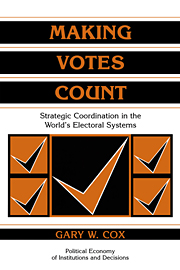Book contents
- Frontmatter
- Contents
- List of tables and figures
- Series Editors' Preface
- Preface
- PART I INTRODUCTION
- PART II STRATEGIC VOTING
- 3 On electoral systems
- 4 Strategic voting in single-member single-ballot systems
- 5 Strategic voting in multimember districts
- 6 Strategic voting in single-member dual-ballot systems
- 7 Some concluding comments on strategic voting
- PART III STRATEGIC ENTRY
- PART IV ELECTORAL COORDINATION AT THE SYSTEM LEVEL
- PART V COORDINATION FAILURES AND DEMOCRATIC PERFORMANCE
- PART VI CONCLUSION
- APPENDICES
- References
- Subject Index
- Author Index
6 - Strategic voting in single-member dual-ballot systems
Published online by Cambridge University Press: 05 August 2012
- Frontmatter
- Contents
- List of tables and figures
- Series Editors' Preface
- Preface
- PART I INTRODUCTION
- PART II STRATEGIC VOTING
- 3 On electoral systems
- 4 Strategic voting in single-member single-ballot systems
- 5 Strategic voting in multimember districts
- 6 Strategic voting in single-member dual-ballot systems
- 7 Some concluding comments on strategic voting
- PART III STRATEGIC ENTRY
- PART IV ELECTORAL COORDINATION AT THE SYSTEM LEVEL
- PART V COORDINATION FAILURES AND DEMOCRATIC PERFORMANCE
- PART VI CONCLUSION
- APPENDICES
- References
- Subject Index
- Author Index
Summary
In the last two chapters, I have investigated strategic voting equilibria in SMSP and in PR elections, two of the three electoral systems that Duverger originally explored in his seminal work in the 1950s. In this chapter, I consider the dual-ballot system, the subject of what was originally Duverger's third proposition.
For dual-ballot systems, Duverger makes no specific claim regarding an equilibrium number of parties. He does argue that such systems produce no incentives to vote strategically in the first round, concluding that “the variety of parties having much in common does not adversely affect the total number of seats they gain since in this system they can always regroup for the second ballot” (Duverger 1954: 240). But this leads only to an expectation that there will be “more than two” parties. The literature on electoral systems has not since produced any more specific prediction and, in a recent survey, Sartori (1994:67) opines that “the reductive effects on the number of parties of the double ballot cannot be generally predicted with any precision” (an opinion shared by Bartolini 1984:118).
This chapter explores the possibility of saying something more precise about the dual ballot's effect. I shall argue two main theoretical points. First, when voters are concerned only with the outcome of the current election and have rational expectations, strategic voting plays a role in dual-ballot elections similar to that it plays in single-ballot plurality elections: acting to limit the number of viable first-round candidates.
- Type
- Chapter
- Information
- Making Votes CountStrategic Coordination in the World's Electoral Systems, pp. 123 - 138Publisher: Cambridge University PressPrint publication year: 1997



